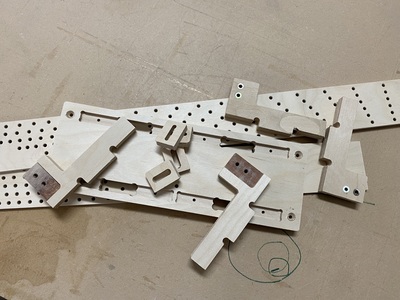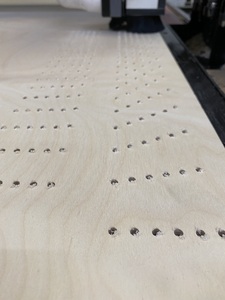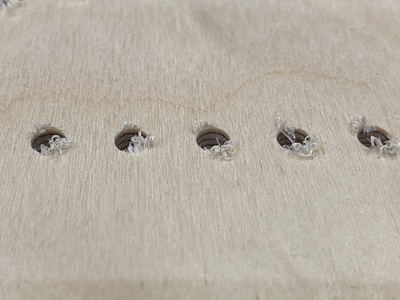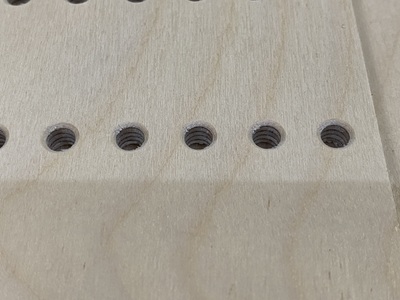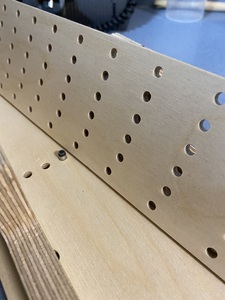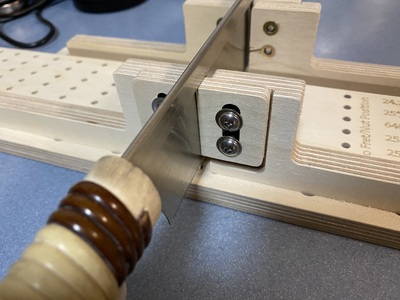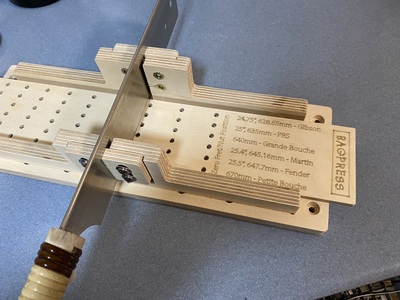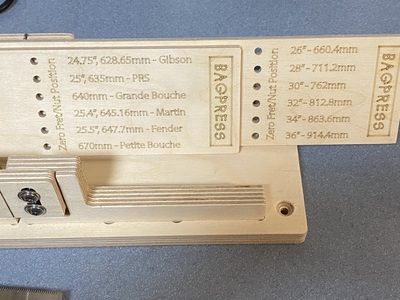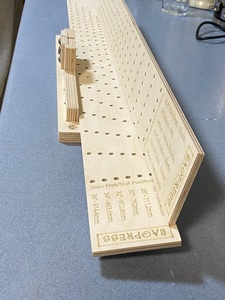Hi peeps,
Just a quick question regarding the most popular scale lengths for acoustic, electric and bass guitars.
What are the most popular scale lengths for acoustic, electric and bass guitars?
The reason I ask is that I am designing a low cost fret slot cutting jig (£60 max target price including a scale length template) that will incorporate multiple scale lengths (up to 6) on a single template. My hope is that I can make one for acoustic/electric and another for bass/baritone and this cover 95% of most popular builds.
All suggestions and advice gratefully received.
Ok, I had a little bit of time today due to missing the live stream! Seriously, I went to YouTube at 13.15 and checked my subscriptions and the only recent GMUK stream showing was the soldering one from last week!
Anyway, the long and the short is that I had the time to finish the drawings and have now machined the first prototype plywood fret slot cutting jig and assembled it. There are a couple of small changes that I would make to a production version but it is, undeniably, a fully working fret slot cutting jig.
The machining takes a reasonable length of time but once I have all the feeds and speeds sorted I won't need to sit and watch it so, other than the materials and cutter wear, the costs should be pretty acceptable, especially given that each scale length template gives the ability to cut 6 different scales.
I did wonder about the registration holes in the plywood templates wearing but, as each hole only gets used once per fretboard, it is unlikely that making even 20 or 30 fretboards is going to result in the template suffering serious wear. And that would be 20 or 30 of the each scale length.
Here is my picture diary of the stages involved.
CNC drilling the template holes in 6mm birch ply.
'Hairy' holes after drilling
Much neater after a shallow countersink is added. This is the underside of the template so the countersink helps to locate the template on the registration pin.
Testing the fit of the registration pin in the template holes. The 5.05mm hole (I KNEW those drills would come in handy!!) is a really good fit. Not too tight but no discernible play either. A slight chamfer around the top edge of the pin (you can't see it here as this is the bottom of the pin) helps it locate in the countersunk holes.
The blocks between which the blade slides have got a layer of PTFE glass cloth stuck on to reduce friction. These are only 9mm thick but provide plenty of support for the blade and allows it to slide very smoothly.
The threaded inserts on the back of the uprights. I will either move the position slightly or use a different insert to prevent the plywood from splitting as it has on the prototype. The narrow strip of PTFE glass cloth below extends the length of the longitudinal fence and just helps to push the template hard against the opposite side fence to keep it aligned and square to the cut.
The jig has 6 registration pin positions meaning that each template can be used to cut 6 different scale lengths. The main part of the jig is made from 15mm birch ply and the parts slot and screw/glue together. Metal construction eg the StewMac jig (and I own one!) is great but is expensive to machine and I feel that it adds cost without contributing much in the way of greater accuracy or general functionality. No ball races on my version, but I guarantee that the saw blade slides with less friction and is easier to adjust.
Just move the pin to the desired position and the template will then index to the correct fret positions for cutting any of the 6 scales lengths available on the template. If you zoom in on this one you can see the chamfer on the top of the reg pin.
The left hand guide pushes hard against the rebate in the upgright and is adjusted for height to give the correct depth of cut. The right hand guide is then pushed to sandwich the blade and tightened. I need one size larger washers for the adjustable side as the slot is too wide for the ones I had in stock. The top of the guides also acts as the depth stop on the back of the saw.
The assembled jig with one of the scale length templates in position.
Two templates = 12 scale lengths. Who's going to be the first to want a 13th? I know who my money is on!!!
To keep costs as low as possible I would aim to supply these in kit form for self assembly. People can then decide for themselves just how much they want to prettify, possibly sanding it to a final 800g or an oil or lacquer finish, or it can just be left in bare plywood. It will work the same however it looks.
I hope this hasn't come across as too much of a sales pitch, it certainly isn't supposed to be. I just like sharing and I really value all of your feedback.
Speaking of feedback, all comments and criticism (constructive or otherwise!) gratefully received.
Cheers
Darren
@jonhodgson Hi Jonathan, I though about laser cutting them and this would certainly work and you could also try using 6mm acrylic, another option I considered. Laser cut holes tend to be slightly large on the underside as the cut flares a little through the thickness of the material so you may have to experiment a little with some very small variations in cut diameter to achieve the perfect fit.
The reason I opted for the CNC drilling is simply that the holes end up being perfectly parallel (which reduces the likelyhood of wear as the reg pin is in contact with more of the hole) and I can machine the little countersink with absolute concentricity (see subsequent post).
@darrenking I know what you mean about the laser flare,plus you mentioning that reminded me that the laser was marginally skew on our cutter last time I checked (not enough to be noticeable in isolation, but if you used it to make a finger jointed box you could see the effect on the corners. I must ask the maintainer if he sorted that.
We don't have a CNC mill, but I guess I could probably use the manual Bridgeport (not sure the maintainers would allow wood, but acrylic should be fine). The DROs on it are accurate to 5um, should be good enough, especially the way I play!
I'm thinking about oddball scale lengths for Ukes, short scale guitars, whatever, not the standard ones that you would supply.
Your design looks very interesting, If you can hit that target pricepoint then once you've given it some proper testing I might be tempted.
BRILLIANT work @darrenking.
It’s about time StewMac had a bit of competition .... how are you going to be selling them (on your website or some other channel/s?)
Online guitar making courses – guitarmaking.co.uk
Thats a nice piece of work. I also like the self assembly idea, easier to package and less likely to be damaged in transit. Just a thought on the taper on the holes if they were to be laser cut, a tapered pin would compensate fot that if the laser flare is consistent, would add to the cost though.
@jonhodgson I intend to have at least one other template with uke scale lengths etc but there is nothing to stop someone making their own. Any CNC or engineering grade drilling/milling machine will easily be capable of the necessary accuracy. When I space the hole positions they are all referenced from the nut rather than the previous fret so there is no accumulation of error. I guess it depends on how long your milling machine slide table is or the travel limits of its digital read out.
@tv1010101 Good morning TV. Glad you like it! I guess I will sell it through my website but if Mark wants to put it in his shop then I am sure that this can be arranged. I’m going to send him one to have a play with over the course of the next week and see how he gets on.
@robin Hi Robin, the laser cut holes don’t taper all that much, it’s just that you have a lesser degree of contact between the pin and the wall of the hole. As I said, if someone wants to sit and play with a laser cutter to determine the best size of hole to give a good fit then this is certainly one option for self cut templates especially if they have the opportunity to make another one if the first starts to display signs of wear or wobble.
@darrenking That truly is amazing! Fantastic idea, making it Ikea style. I’ll buy a few from you, do we all get a discount as we are all friends here? 😀
Make guitars, not war 🌍✌️🎸
Very neat and clever @darrenking.
I have too many guitars...said no one in the world..ever!
As soon I have finalised pricing with Mark and Carol you'll be one of the first to know!
@darrenking That’s great, I appreciate it. I think someone has already said this but it’s about time someone came along and made a more accessible fret slotting jig, it’s definitely competition for StewMac or any of the other companies that have made exact copies that are also expensive. I’ve got friends that will love this, the reason we all had a go at making our own is that buying one was just too expensive. I don’t know your pricing but if they are quite a bit cheaper than the others, it will bring you more business and Mark and places that sell fretsaws. Everyone wins including people who are interested in making guitars but have been put off in the past because of the price of specialist tools. We are sadly lacking in the U.K. a manufacturing, distribution centre and outlet for good quality, inexpensive guitar making tools. There are a few good ones knocking about Europe but otherwise it’s StewMac in America, that will not do. You are on to something Darren, keep going.
Make guitars, not war 🌍✌️🎸



